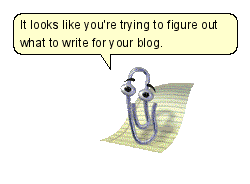Who knew blogging was gonna be so much work?
It seemed so easy back when you started. A post a week? No biggie! Let’s do this thing!
But eventually, you start running out of ideas. You start having more urgent things you need to deal with. All of a sudden, writing that regular post is a Sisyphean task you’d do just about anything to get out of.
It doesn’t have to be such a chore.
Writing an awesome blog post and getting people to actually read it does NOT have to be the worst part of your week – you just have to approach it with the right mindset. Whether you feel like you’re running out of ideas, your headlines are too boring, or you can’t figure out how to get more traffic from social media, this is how to get rid of writer’s block our process will help you get un-stuck and publishing posts like a pro.
Why “I don’t know what to write about” is the worst excuse ever
Some writers like to pretend that writer’s block is a thing that doesn’t exist.
99% of them are liars. (The other 1% are Terry Pratchett, who published more than 75 books and thereby earned the right.)
Everyone suffers from writer’s block at some point, so when you sit down in front of that blank Word doc and have no idea what to write yet another blog post about, you’re not alone – and it’s not an excuse.
[easy-tweet tweet=”Overcoming writer’s block isn’t passive – it’s something you have to put work into.” usehashtags=”no”]

Most people, when they don’t know what to write, act like they do when they want a snack. You go to the fridge not really knowing what you want, idly look inside for a minute, then close the door without having chosen anything.
Then you do it again in five minutes, just in case something magically appeared when you weren’t looking.
Ideas don’t magically appear – they come from somewhere, and you have to find them.
The blinking cursor on the blank page isn’t your friend, and it’s not going to help you figure out what to write. You can ask Clippy if you want, but trust me, he doesn’t know jack.
If a brilliant idea just so happens to come to you all on its own, and you’re feeling inspired right off the bat, then great – but don’t trick yourself into believing that this is how it’s always supposed to work. (Unless you want to start off every blog post by doing this.)
How to get rid of writer’s block
When it comes to beating writer’s block, start by asking yourself a few of these questions, which can help point you in the right direction:
What’s going on in your world?
It sounds silly at first, but it’s easy to forget: what you do is special. Your business immerses you in a culture that most people know very little about, and probably don’t have the time or means to understand all on their own. (If I asked my parents what a Facebook algorithm is, they’d probably guess that it’s some kind of dance.)

So don’t take for granted that you’ve got your ear to the ground! You are your readers’ person on the inside – the one with the scoop on everything going down that they might want to know. You keep up with the latest studies, news, and trends so that they don’t have to.
Here’s an example. We read a lot about social media around these parts. Major headlines, new data and studies, trends, you name it. Back in January, we came across a statistic we thought was pretty interesting, and wrote a blog post explaining why it matters.
Within two weeks, it was our most-shared blog post of all time.
Is it because it was the best blog post we ever wrote? Probably not. But it was about something that most people probably weren’t aware of, despite the fact that it’s relevant to their interests.
You know what’s going on in your industry in a way that your readers don’t. If you’re a career counselor, you know what HR professionals look for in a resume today. If you’re a dog dietician, you know what the latest studies are saying about proper nutrition. If you’re an interior designer, you know whether mid-century modern is in or out right now.
Share what you know and learn with your readers, and bring something to the table along with it. Offer your expert opinion, have a unique point of view. Analyze. Agree with what you read, or disagree, it doesn’t matter – you’re an authority in your field, so act like it.
What do you know how to do?
Remember participating in Take Your Child to Work Day?
My dad’s a pharmacist in a hospital, which means part of his job is mixing and filling IV bags with whatever narcotic cocktail a patient may need.
Now to him, this is probably the most mundane task imaginable. The number of times he does this in a week is probably somewhere between one and two billion. But when I was a kid on Take Your Child to Work Day, watching him do this was fascinating, because I’d never seen it done before! I had no idea what this process was like, and that made it really, really interesting.
The things that seem elementary to you can be groundbreaking for your readers, so don’t write them off.
Over at Social Media Examiner, a task like optimizing images for social sharing is about as routine as it comes. They know this topic inside and out – they must do it a dozen times a week (but more on that later). That didn’t stop them from writing about it, though, because they know that their blog’s readers don’t necessarily have the same depth of knowledge on the subject that they do. (And consequently, this post racked up more than 7,000 shares in under two weeks.)
The things you know, and that you know how to do? Not everyone knows those same things, so share your expertise. Just because you wouldn’t need a particular guide or how-to article doesn’t mean that your readers don’t – in fact, it could be quite the opposite.
What have you learned?
There’s a reason 70% of consumers look at a product review before making a purchase – we prefer concrete truths to guesses and hypothetical situations.
While offering your readers insights into the things they should try is valuable, giving an inside look at what happened when you or someone else actually did it can be even better.
Just look at a few headlines from Copy Hackers:
- How We Optimized the Mad Mimi Pricing Page
- The Non-Scuzzy and Totally True Story of How I Earned 6 Figures in 12 Months by Mastering the “Hidden Elance Economy”
- I Spent All Summer Running A/B Tests, and What I Learned Made Me Question the Whole Idea
There’s a reason they’re one of the best resources online for anyone who wants to write better marketing copy. Every single one of these promises a story, and simply put, stories are interesting. (You’ll never tuck a child into bed and have them ask you to tell them a blog post.) This is your version of ripped from the headlines – a true tale that taught you a valuable lesson about, well, whatever it is that you do!
The trick, of course, is to think like Aesop – every story has a moral. The hare learns that slow and steady wins the race, the lion is rescued by the mouse to whom he showed mercy, and the boy who cried wolf gets his lying keister ripped to pieces – these stories have endured for literally thousands of years in part because they teach valuable lessons.

When Help Scout wrote a blog post about their experience building a remote company culture, it wasn’t just a story about themselves – they made its lessons relevant and applicable to their readers. You find out not just what happened to them, but what they learned from it, and how those lessons may apply to you and your own business. So share what you know, what you’ve tried, what you’ve experienced – even the times you’ve failed – but make sure that your readers can apply what they learn to themselves, too.
What do your readers want?
Still stumped about how to get out of writer’s block? Just look at what’s worked before.
For example, we’ve noticed in the past that blog posts about Instagram are popular for both traffic and shares – so we revisit the topic on occasion, and it usually works out pretty well.
Keep track of how your blog posts perform – traffic, shares, comments – so when writer’s block strikes, you can take a quick look at what’s worked before and use it as inspiration. (For example, we maintain a spreadsheet that collects these stats on a monthly, quarterly, and annual basis, so we always know what’s striking a chord with our readers.)
Now that you know what to write about, just write it!
Wait, no. Actually, don’t do that.
Ever been to a wedding where the best man obviously didn’t plan his toast ahead of time? You don’t want to be that guy – the one rambling and nervously clutching his champagne flute while the audience wonders when he’s going to get to the point.
Be the writer who plans ahead, and knows exactly what they want to say and how they’re going to say it. Even bestselling authors like J.K. Rowling rely on outlines that they plot out in advance so that they know how all the pieces will fall into place before they start actually writing:

Source: Flavorwire
Granted, your blog post probably won’t be 896 pages long, so your outline doesn’t have to be quite so in-depth. Even if you just take 10 or 15 minutes to scribble down a few bullet points before you start writing, you’ll at least have an idea of how you want to structure your post.
What points do you want to get across? How should those points be organized? What examples, stats, or links do you want to make sure you don’t forget to add while you’re writing? When you figure these things out first and plot them in an outline, the actual writing process feels like a lot less work – it’s like googling directions before you leave the house, instead of just assuming you’ll figure out how to get where you’re going based on instinct.
When it comes to how to get over writer’s block, outlines beat the block every time! When you have a shape for the writing to fit into, it is way less overwhelming!
Now you can finally write this thing!
You know what you want to say, and you know how you want to say it – it’s time to put pen to paper (or fingers to keys) and actually get this thing written.
What you write in your blog post is up to you, but there’s something very important you should do after you write it:
Don’t publish it.
Seriously, put it away. Walk the dog. Sleep on it. Do pretty much anything except publish that post you just wrote, because it’s not ready. (Walking, sleeping, and changing your scenery are all great ways to beat writer’s block before you write the post too just fyi!)
There’s a reason we always write our blog posts at least a week in advance – it gives us time to step away and come back to look at them with fresh eyes. (Case in point: I wrote “we always right our blog posts” and didn’t catch the typo until two days after I finished the first draft.)
You’ve never read anything in your life that was published after one draft. Not a blog post, or a newspaper article, or the back of a cereal box – everything gets revised before it gets published, and your work should be no different.
Science shows us that the more familiar your work is to you, the less likely you are to catch an error.
You’re likelier to miss not just embarrassing, obvious stuff like typos, but actual errors in structure and logic, too – basically, you could publish your post without realizing that you left out something important (even if you outlined first).
De-familiarize yourself with your post before you publish. Get your mind thinking about something else, then come back. (It may even help to approach it in a new context. For example, print it out and proofread by hand – this helps eliminate the subconscious biases that can make you overlook errors.)
After you’ve polished, proofread, revised, rewritten, washed, rinsed, and repeated, it’s time to write an amazing headline. Writing headlines is so important that you can find dozens of articles dedicated solely to that task, and you should probably read them. As advertising legend David Ogilvy put it when you’ve written your headline, you’ve spent 80 cents out of your dollar – it’s arguably the most important piece of the equation!

Every time we write a blog post, we come up with at least 15 different headlines, then choose the one we like best. Sometimes they’re all drastically different, and sometimes only a few words change between them. Sometimes the best headline is the one we write last, sometimes it’s the one we write first. Give yourself options – you’re likelier to surprise yourself than you may realize.
Once you’ve got your words all sorted out, don’t forget to give your blog posts a visibility boost with images.
In the context of the post itself, images break up those massive walls of text and can provide handy dandy visual aids, like in this post from Copy Hackers:
(And yes, that’s an image in a blog post of an image in a blog post. Blog-ception.)
When you’re adding images, though, don’t just think about how they’ll look in the context of the blog post – think about how they’ll contribute to your social media visibility.
Adding a photo to a tweet can increase its retweets by 35%. Link posts get the best organic reach on Facebook, and those pull images from the destination URL. You don’t need fancy schmancy image editing software to put these things together, either – you can do it all on your own for free.
An eye-catching image can come from anywhere – Social Media Examiner, for example, creates a header image to go with almost every single one of its posts:
When they share that the link to that post on social media, then, they can use that image to increase its visibility and emphasize the title – because you remember just how important headlines are.
But speaking of social media, your work isn’t quite done.
It’s time to actually get some readers!
Obviously, social media is hugely important to driving traffic to your blog. It broadcasts the link out to your followers, and when they share it, it puts your website in front of people who have maybe never even heard of it before. (Hence why those statistics about increasing retweets with images are so important.)
But how many times can/should you promote your blog post? Once or twice, something like that?
Promote your blog post frequently. Promote ALL your blog posts frequently.
Statistically speaking, whether you’re posting on Facebook or Twitter, most of your fans aren’t going to see any given update. The majority of them don’t sign on to Twitter even once a day, and at the very most, your link posts will reach less than a third of your Facebook followers.
If you only share a link a few times, you’re only hitting a teeny tiny segment of your audience – and frankly, if you’re writing a blog post and not sharing it with many of your followers, you’re wasting your time.
Career Contessa found that by posting a steady stream of links to their blog posts (among other social updates, of course), they increased their Twitter referrals by 655%. It wasn’t because they were writing more blog posts – it was because they made the most of the ones they already had.
We do the same thing here – unsurprisingly, using Edgar. Edgar allows us to write, upload, and save our blog-related updates all under one category, then schedule when we want updates from that category to be shared on social media. Every time we write a post, it gets added to the Library, and when the time comes for Edgar to share a blog post on social, he chooses one, shares it, then shuffles it back in at the bottom of the deck to be shared again at a later date.

You can do this manually if you prefer, but the important thing is that you do it at all. When you promote your blog posts again and again over time, you make sure that all the work you put into writing them doesn’t go to waste, and you make it easy for brand new people to discover your work.
Hey look! You learnt how to beat writer’s block!
That’s all there is to it – now, wasn’t that easy? So remember, when it comes to how to overcome writer’s block to blog like a pro:
- Brainstorm up a killer idea
- Outline your main points
- Write, walk away, revise
- Craft some irresistible headlines and shareworthy images
- Post and promote (and promote, and promote)
Follow those steps, and your blogging routine will actually feel like it’s worth the time and effort!







